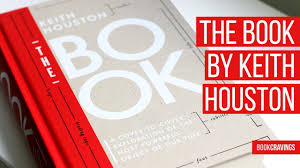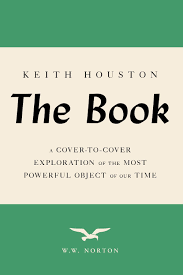Keith Houston, The Book: A Cover to Cover Exploration of the Most Powerful Object of Our Time (2016).
Good Reads meta-data is 442 pages rated 4.09 by 1161 litizens.
Genre: History.
DNA: USA.
Verdict: A synthesis.
Tagline: ‘It takes a strong will to resist the lure of ebooks.’

So many books are about books it is no surprise that there are books about the physical object we call a book: A biography of the book.
What I learned about the evolution of the book was that it is a tale of laborious trial and error by many hands over several millennia to get to the book as we kne/ow it: Paper, ink, fonts, binding. Gutenberg was one of a cavalcade of obsessives who went broke trying to improve book printing.
Other tidbits include the following:
Book-locks which I have seen were not parental controls which I had thought but to tighten closed books so that the parchment would not curl.
The consequences of shelving books on end rather than lying flat were many. See also, Henry Petroski, The Book on the Bookshelf (2000) on this point.
In many cases fonts were named for the first to develop them. From Italy Italic was a reaction to the heavy Gothic type Gutenberg used.
Foolscap paper derived from a watermark left on certain size sheets of paper in England 17th Century after the fall of monarchy. The crown was replaced by a ‘Fool’s cap’ watermark as sign of loyalty to the new order.
Paper sizes A1 to A10 originated in Germany. A1= 1/2 a square meter, each subsequent size is a half of its predecessor. Sizes of paper originated with the reach of workers who made paper.
- Georg Christoph Lichtenberg (1786): The initial idea for a proportional paper system came from this German scientist. He proposed a width-to-height ratio of 1:√2, recognizing its mathematical efficiency for scaling. A sheet of paper with this ratio can be folded in half to produce two smaller sheets that have the exact same proportions as the original.
- Dr. Walter Porstmann (1922): German engineer formalized Lichtenberg’s concept into the DIN 476 standard. This standard set the largest size, A0, to have an area of exactly one square meter, with all other “A” sizes defined by successively halving the larger sheet. Such a progression is called geometric harmony.
- Codified by International Standard Organisation in 1975.
I also found a clanger when author says Herbert Hoover was Secretary of State in Woodrow Wilson’s cabinet (p 418). Not only was Hoover not Secretary of State, he was not in cabinet at all, though he certainly worked closely with Wilson’s administration.
More interesting was James John Audubon:
- born in Haiti to slave owning family of planers. The family returned to France when the slave revolt stirred. In 1814 family sent teenage James John to Pennsylvania to avoid conscription in Napoleon’s endless wars.
- He was a boy naturalist, first in Haiti, then France, then USA.
- Tried to make a living out of his naturalist interest. Bird book with travels. No one in USA wanted to publish it. Took it to London. No. Then Edinburgh where he succeeded.
- One copy of all ‘textual books’ must be given to British Library. He only had 200 and was deeply in debt. Didn’t want to surrender even one copy for nothing. So extracted text describing locale and birds from the pictures and printed it separately and compared to the illustrated book this textual book sold cheaply and gave that to the BL, but not the picture book.
In medieval Europe mirrors were used by the faithful to reflect divine rays from relics onto pilgrim. A good business for touts outside churches selling mirrors. A proto selfie?
So many technical details, so many proper names I got lost in the morass.
Remember the Norwegian ‘Medieval helpdesk’ on You Tube? It is still there.
Author opens with that tagline above and then says little or nothing about ebooks. Whoops, no that silent withdrawal of Nineteen Eighty-Four (p 9), though he used the numeric title and not the words. Orwell stipulated words not numbers for the title, but no one listens to authors. Certainly not publishers.

Me, I compared the resistance to printed books (leads to atrophy of memory, allows rubbish to be published and read, makes us solitary rather than conversational and convivial, and class aesthetics because printers were begrimed working class, whereas scribes were learned, devout monks) to current resistance to ebooks (too fiddly, put bookstores out of business, allows a tidal wave of crap, and does not have the aesthetic qualities of a nice book). Certainly right about the crap. I can leave the aesthetics to others. Video dented but did not destroy cinemas and I hope digital books will not destroy bookstores. What has already destroyed far more bookstores were the predatory mega franchise chains like Barnes and Noble, Borders, Smith, Waterstone, and their ilk which set out to do so with pricing and location.

